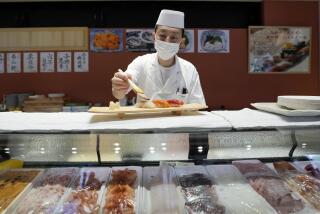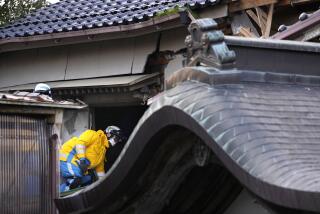Japan’s economy stumbling in wake of disaster
The world’s third-largest economy faltered Monday, the first full business day since Friday’s devastating earthquake, with the Japanese stock market plunging and the country’s central bank moving to inject $183 billion into money markets to try to stem the financial damage.
Although the quake’s fury bypassed Japan’s industrial heartland, the shock waves were felt throughout the business sector, from big auto plants to small mom-and-pop establishments. Many of Japan’s leading companies, such as Sony Corp. and Toyota Motor Corp., closed some production facilities, further jeopardizing the exporting powerhouse.
On Monday, the Nikkei stock average fell 6.2%, and the broader Topix index plunged 7.5% — both their steepest daily declines since October 2008, when markets were seized with the global financial crisis.
Photos: Scenes of earthquake destruction
The prospect of rolling power outages, together with transport problems that made it impossible for many people to get to work, put a severe damper on business activity, amid estimates of $170 billion in losses resulting from the quake, which was the strongest temblor ever recorded in Japan.
Hiromichi Shirakawa, chief economist at Credit Suisse in Tokyo, said damage from this quake was smaller than the Kobe earthquake of 1995, because it struck an area of the country where the main industries are fisheries and agriculture. The longer-term effect of power shortages and evacuations triggered by quake damage at nuclear power plants is more difficult to assess, he said.
“There could also be an adverse psychological impact on consumers from the power cuts and the nuclear plants that are in danger of melting down — not just in the region that sustained damage, but also Tokyo and the surrounding areas,” Shirakawa said. “It could affect other regions across the country. It’s almost impossible to assess that impact on growth.”
The government was expected to implement an emergency spending package of between $25 billion and $37 billion, he said. But longer-term power shortages arising from the quake could dampen manufacturing output.
It will be hard to jump-start the economy unless people can get to work. Service was curtailed on train lines between Tokyo’s suburbs and to neighboring cities. Within the capital, subway trains were running sluggishly as well, leading to sightings of flocks of bicycles on the city’s streets.
Many took the disruptions in stride. At Urawa station in Saitama, north of Tokyo, more than 100 people stood in a line for taxis after arriving early Monday and finding the station closed. A railway staffer stood outside a closed metal shutter, bowing and explaining that the trains would not be running. Some commuters then rushed to catch a bus that was headed toward Tokyo.
The infusion of cash from the Bank of Japan was likely be the first of many government measures to stabilize the nation’s economy. The central bank said it wanted to provide ample liquidity to ensure that money was available to rebuild the country from what the Japanese prime minister called its worst hardship since World War II.
Interest rates in Japan are already near zero, giving the central bank few tools other than pumping cash into the economy.
But that comes with added risk. Japan carries one of the largest debt burdens of any industrialized nation — equal to twice its annual economic output.
The full cost of the disaster may not be known for some time. Officials were still assessing the damage in hard-to-reach northeastern Japan, where tens of thousands are still missing. Workers were also scrambling to prevent several nuclear power reactors from melting down.
“Total economic losses will likely exceed $100 billion,” said a report issued by catastrophe modeling firm Eqecat. “Key components of this will be extensive property damage to residential and commercial occupancies and restoration of critical infrastructure.”
Tom Byrne, lead analyst for Japan at Moody’s, said that would amount to 2% of Japan’s annual gross domestic product.
“Big, wealthy economies like Japan can usually cope with these sorts of disasters,” Byrne said. “We don’t expect any inability to fund the reconstruction costs. However, the fiscal deficit puts more pressure on the government over time to have a revitalization plan.”
Byrne said Japan leads the developed world in international assets as a percentage of its GDP, which gives the country ammunition to finance the rebuilding. Those assets can be liquidated and repatriated as yen. If that results in a stronger currency at the expense of the nation’s exports, the central bank will probably print more money to devalue the yen.
Analysts say Japan’s stagnant economy will see steep declines in consumption but then experience growth as reconstruction efforts take hold. But the boost will be unsustainable unless the country finds a solution to its aging population, which has made the domestic economy increasingly unproductive over the years.
With railway companies operating limited services in the Tokyo metropolitan area, many companies told employees not to report for work Monday. Nissan, cosmetics maker Shiseido, Asahi Breweries, and JFE Steel told employees who commute on lines that weren’t running to stay at home. Watchmaker Citizen said more than 1,000 employees couldn’t make it to work.
Businesses were also letting employees take time off to search for loved ones missing in the quake and the huge tsunami it spawned.
The head of Japan’s powerful business lobby Keidanren, Hiromasa Yonekura, told reporter that businesses were expected to pitch in by cutting back on electricity use. “Businesses need to try to rely as much as possible on in-house power generators,” he said.
Nissan shuttered all its factories Monday. Six of its domestic assembly plants and thousands of vehicles in storage and on transport ships had sustained some damage. Many of its dealerships in Fukushima and Miyagi prefectures, the heart of the quake zone, were thought to have sustained damage.
Photos: Scenes of earthquake destruction
Others that announced production suspensions Monday included carmakers Mitsubishi Motors; Suzuki Motor Corp.; Fuji Heavy Industries, which makes Subarus, and truck maker Hino Motors. Toyota, Honda and many auto-parts makers also put their factories on hold Monday.
The disruption in parts production was also expected to spill over to carmakers’ plants in other countries, though those factories could eventually make up for the drop in domestic production.
Related:
Grim recovery effort along Japan’s coast
Japanese American groups in L.A. use Web to respond to quake
Global rescue teams pour in as death toll soars and electricity is rationed
Hall, a special correspondent, reported from Tokyo. Staff writer Pierson reported from Beijing. Staff writer Laura King in Tokyo contributed to this report.







